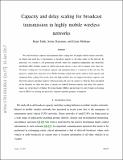Capacity and delay scaling for broadcast transmission in highly mobile wireless networks
Author(s)
Talak, Rajat Rajendra; Karaman, Sertac; Modiano, Eytan H
Download1701.04130.pdf (521.7Kb)
OPEN_ACCESS_POLICY
Open Access Policy
Creative Commons Attribution-Noncommercial-Share Alike
Terms of use
Metadata
Show full item recordAbstract
We study broadcast capacity and minimum delay scaling laws for highly mobile wireless networks, in which each node has to disseminate or broadcast packets to all other nodes in the network. In particular, we consider a cell partitioned network under the simplified independent and identically distributed (IID) mobility model, in which each node chooses a new cell at random every time slot. We derive scaling laws for broadcast capacity and minimum delay as a function of the cell size. We propose a simple first-come-first-serve (FCFS) flooding scheme that nearly achieves both capacity and minimum delay scaling. Our results show that high mobility does not improve broadcast capacity, and that both capacity and delay improve with increasing cell sizes. In contrast to what has been speculated in the literature we show that there is (nearly) no tradeoff between capacity and delay. Our analysis makes use of the theory of Markov Evolving Graphs (MEGs) and develops two new bounds on flooding time in MEGs by relaxing the previously required expander property assumption.
Date issued
2017-07Department
Massachusetts Institute of Technology. Department of Aeronautics and Astronautics; Massachusetts Institute of Technology. Laboratory for Information and Decision SystemsJournal
Proceedings of the 18th ACM International Symposium on Mobile Ad Hoc Networking and Computing - Mobihoc '17
Publisher
Association for Computing Machinery (ACM)
Citation
Talak, Rajat, Sertac Karaman, and Eytan Modiano. “Capacity and Delay Scaling for Broadcast Transmission in Highly Mobile Wireless Networks.” Proceedings of the 18th ACM International Symposium on Mobile Ad Hoc Networking and Computing - Mobihoc ’17 (2017).
Version: Original manuscript
ISBN
978-1-4503-4912-3